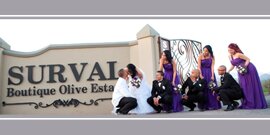{Advice} Ceremony seating 101
Families are complicated. So is figuring out where they’ll sit during the ceremony. Until now… We’re here to help. Family, friends, and family friends, where should they sit during your big moment? With parents, stepparents, divorced parents, grandparents, and extended family all in attendance, you’ll need a plan. Here are our guidelines…
Ushers Who Are They?
You can enlist a few of your groomsmen to play ushers, or you can ask some relatives or friends to seat your guests. The rule of thumb is one usher for every 50 guests. If you’re having an intimate ceremony, you may not need ushers, but you might want to put someone in charge of ‘sensitive’ seating issues – like keeping your mom and stepmom apart.
Ushers need to know where everyone’s supposed to sit, so print out a list for them. Traditionally, female guests are escorted to their seats; the usher offers his right arm to the woman, and her male companion follows them down the aisle (with a group of women, the usher might offer his arm to the oldest woman). These days, it’s fine for ushers to simply greet guests at the door and lead them to their seats, saying, “Please follow me.”
Taking Sides
Ushers needn’t ask guests whose ‘side’ they are on. In Christian ceremonies, the bride’s side is the left side of the church when looking from back to front, and the groom’s side is the right; for Jewish services, it’s the opposite. But should someone express a preference for one side or the other (many guests will say they are friends or relatives of the bride or groom), they should be seated where they want to sit. If one side of the family will have more guests than the other, ushers should try to even things out, explaining that everyone will sit together so guests can get the best view possible.
Who Sits Where?
Quick answers to your most frequent seating questions:
• Elderly guests should be seated near the front.
• Guests in wheelchairs or on crutches should sit at the end of a pew.
• The first four or five rows may be reserved for immediate and extended family (like aunts, uncles, cousins, and godparents) and other special guests (like the parents of a child attendant) by tying ribbons across those rows.
• Immediate family is seated just before the ceremony begins. Siblings (if they’re not in the wedding party) are seated before grandparents and great-grandparents. They sit either in the first row with parents or in the second row with grandparents. Start seating with the groom’s side.
• If you have step-relatives, make sure ushers know who they are. Step-relatives should be escorted to their seats first – for example, step-grandparents precede birth grandparents. You may want to reserve a few extra rows directly behind immediate family for step-grandparents and stepsiblings.
• If the bride’s or groom’s parents are divorced, seat the parent who primarily raised the bride or groom in the front row with his/her spouse, and seat the other parent and his/her spouse in the third row. Alternatively, birth parents may sit beside each other in the first row, or they may share the front row with stepparents. Discuss this in advance to avoid awkward moments.
• The bride’s mother is always seated last at a Christian ceremony; the groom’s mother is seated just before her. In Jewish ceremonies, parents stand under the chuppah with the couple. The seating of the bride’s mother signals that the ceremony is about to begin.
• Brothers of the bride and groom usually seat their mothers; the head usher can do it if the brothers are in the wedding party, or a brother can seat his mom and then take his place with the other groomsmen.
















































Leave a Reply